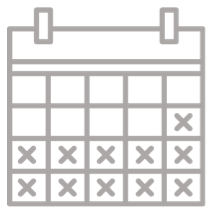00:00-00:45
[Taltz logo with dosage on screen in lower right corner.]
Caption:
INDICATIONS
Taltz is indicated for patients aged 6 years or older with moderate-to-severe plaque psoriasis (PsO) who are candidates for systemic therapy or phototherapy. Taltz is also indicated for adults with active psoriatic arthritis (PsA), for adults with active ankylosing spondylitis (AS), and for adults with active non-radiographic axial spondyloarthritis (nr-axSpA) with objective signs of inflammation.
CONTRAINDICATIONS
Taltz is contraindicated in patients with a previous serious hypersensitivity reaction, such as anaphylaxis, to ixekizumab or to any of the excipients. Full Important Safety Information is available at the conclusion of the video.
Narrator: INDICATIONS, Taltz is indicated for patients aged 6 years or older with moderate-to-severe plaque psoriasis (PsO) who are candidates for systemic therapy or phototherapy. Taltz is also indicated for adults with active psoriatic arthritis (PsA), for adults with active ankylosing spondylitis (AS), and for adults with active non-radiographic axial spondyloarthritis (nr-axSpA) with objective signs of inflammation.
CONTRAINDICATIONS, Taltz is contraindicated in patients with a previous serious hypersensitivity reaction, such as anaphylaxis, to ixekizumab or to any of the excipients. Full Important Safety Information is available at the conclusion of the video.
00:46-01:10
[Photograph of Taylor sitting in an armchair appears after caption fades away. Animation shows plaques appear on Taylor’s arms and scalp and his nails are discolored. Close up photographs highlight his scalp and nail psoriasis.]
Caption:
Patient Manifestations to Consider When Choosing Taltz for Moderate-to-Severe Plaque Psoriasis
Not an actual patient.
Narrator: Patient Manifestations to Consider When Choosing Taltz for Moderate-to-Severe Plaque Psoriasis. This is Taylor. Each day of Taylor’s life is full of special moments. Taylor struggles with moderate-to-severe plaque psoriasis that manifests as visible plaques on his skin, even in challenging body areas like the scalp or nails.
01:11-01:36
[Photograph of Taylor looking out a window, where he sees individuals walking in a park. Animation shows cutouts of clothing float over to show Taylor wearing the clothing, covering up his his plaques. The scene shifts to Taylor sitting in the waiting room of his dermatologist.]
Caption:
Not an actual patient.
Narrator: While Taylor understands that these symptoms are common with his condition, he can’t help but be embarrassed by what others might think. As a result, Taylor always makes sure to cover up, even on a visit to his dermatologist. There is nothing that Taylor wants more than rapid improvements with long-lasting results because every day is special.
01:37-02:09
[Captions animate to fill the screen.]
Caption:
TALTZ REGISTRATION TRIALS:
Multicenter, randomized, double-blind, placebo-controlled1,2
UNCOVER-1: UNCOVER-2, UNCOVER-3
FOR ADULTS WITH MODERATE TO SEVERE PLAQUE PSORIASIS
SCREENING RANDOMIZATION
12-WEEK INDUCTION PERIOD
UNCOVER-1 (N=864)
Taltz 80 mg every 2 weeks* (n=433)
Placebo (n=431)
UNCOVER-2 (N=877)
Taltz 80 mg every 2 weeks* (n=351)
Enbrel§ 50 mg twice weekly (n=358)
Placebo (n=168)
UNCOVER-3 (N=960)
Taltz 80 mg every 2 weeks* (n=385)
Enbrel§ 50 mg twice weekly (n=382)
Placebo (n=193)
RE-RANDOMIZATION
At Week 12:
Taltz Responders (sPGA, 0,1)
Re-Randomized To Taltz Q4W
(n=221) and PBO (n=211)
MAINTENANCE PERIOD
Taltz 80 mg every 4 weeks
UNCOVER-1 (n=119)†
UNCOVER-2 (n=102)†
Placebo every 4 weeks
UNCOVER-1 (n=117)
UNCOVER-2 (n=94)
OPEN-LABEL, LONG-TERM EXTENSION PERIOD
Taltz 80 mg every 4 weeks (n=362)
At Week 12:
ALL patients went to Q4W Taltz
Week 0
Week 12
Week 60
Week 264
Co-primary efficacy endpoints at Week 12
- Proportion of patients achieving PASI 75
- Proportion of patients with sPGA 0,1 with at least a 2-point improvement from baseline
*Taltz-treated patients received a 160 mg starting dose
†Intent-to-Treat population: patients RANDOMIZED to receive 160 mg starting dose, 80 mg every 2 weeks for 12 weeks, and 80 mg every 4 weeks in the in the maintenance period.
§US-approved etanercept
PASI=Psoriasis Area Severity Index; sPGA=static Physician Global Assessment.
Narrator: That’s why Taylor’s dermatologist prescribes him Taltz, believing it to be a treatment that can offer him his desired results. The designs of the Taltz registration trials in adults with moderate-to-severe plaque psoriasis are shown here. The co-primary efficacy endpoints of the trials were the proportion of patients with an sPGA of 0,1 and at least a 2-point improvement from baseline and proportion of patients achieving PASI 75 at Week 12.
02:10-02:50
[Captions animate to fill the screen.]
Caption:
TALTZ DEMONSTRATED COMPLETE AND CONSISTENT CLEARANCE1
UNCOVER-1, UNCOVER-2, UNCOVER-3
FOR ADULTS WITH MODERATE TO SEVERE PLAQUE PSORIASIS
PASI RESPONSE at Week 12, NRI
UNCOVER-1
Taltz (n=433)
PBO (n=431)
UNCOVER-2
Taltz (n=351)
PBO (n=168)
UNCOVER-3
Taltz (n=385)
PBO (n=198)
PATIENTS ACHIEVEING RESPONSE (%)
0, 25, 50, 75, 100
PASI 75
TALTZ, 89 (UNCOVER-1), 90 (UNCOVER-2), 87 (UNCOVER-3)
PBO, 4 (UNCOVER-1), 2 (UNCOVER-2), 7 (UNCOVER-3)
PASI 90
TALTZ, 71 (UNCOVER-1), 71 (UNCOVER-2), 68 (UNCOVER-3)
PBO, 1 (UNCOVER-1), 1 (UNCOVER-2), 3 (UNCOVER-3)
PASI 100
TALTZ, 35 (UNCOVER-1), 40 (UNCOVER-2), 38 (UNCOVER-3)
PBO, 0 (UNCOVER-1), 1 (UNCOVER-2), 0 (UNCOVER-3)
sPGA 0,1 at Week 12, NRI
UNCOVER-1
82% of patients on Taltz vs 3% on PBO
UNCOVER-2
83% of patients on Taltz vs 2% on PBO
UNCOVER-3
81% of patients on Taltz vs 7% on PBO
In the maintenance period of UNCOVER-1 and -2, 75% of the patients on Taltz who achieved sPGA 0,1 at Week 12 maintained that response at Week 60 (n=181*) vs 7% of patients on PBO (n=203*) (NRI analysis).1
Patients who achieved clear or almost clear skin (sPGA 0,1) after initial treatment with Taltz 80 mg every 2 weeks were rerandomized at Week 12 to receive either Taltz 80 mg every 4 weeks (n=181*) or placebo (n=203*). *Evaluable patients at Week 60.
NRI = non-responder imputation, PASI = Psoriasis Area Severity Index; PBO = placebo; sPGA = static Physical Global Assessment
Narrator: As a biologic for adults with moderate-to-severe plaque psoriasis, Taltz has demonstrated consistent and maintained skin clearance results. At Week 12 in UNCOVER trials, up to 90% of Taltz patients achieved PASI 75, up to 71% achieved PASI 90, up to 40% achieved PASI 100, and up to 83% achieved sPGA 0,1. In UNCOVER-1 and UNCOVER-2, of those who achieved sPGA 0,1 at Week 12, 75% maintained that response at Week 60.
02:51-03:08
[Captions animate to fill the screen.]
Caption:
RAPID IMPROVEMENT AT 12 WEEKS SUSTAINED THROUGH 5 YEARS3
UNCOVER-3: PATIENTS ACHIEVING PASI 90 and 100, OBSERVED4
FOR ADULTS WITH MODERATE TO SEVERE PSORIASIS
RAPID RESPONSE at Week 12
PATIENTS ACHIEVING RESPONSE (%)
0 20 40 60 80 100
PASI 90, PASI 100
WEEK 12 (Nx=365*), 40%, 72%
YEAR 1 (60 weeks Nx=335*), 64%, 84%
YEAR 2 (108 weeks Nx=305*), 58%, 81%
YEAR 3 (156 weeks Nx=248*), 65%, 87%
YEAR 4 (204 weeks Nx=222*), 67%, 88%
YEAR 5 (264 weeks Nx=194*), 66%, 90%
Induction Period
Open-Label Extension Period
PATIENTS ACHIEVING RESPONSE (%), mNRI
PASI 90, PASI 100
WEEK 12, 70%, 39%
WEEK 60, 78%, 59%
WEEK 108, 71%, 50%
WEEK 156, 69%, 49%
WEEK 204, 66%, 48%
WEEK 264, 67%, 46%
*Nx=observed population
These were post hoc analyses of ITT population throughout Week 264. The open-label phase of the study has limitations (eg, no placebo comparison, patients remaining in the extension phase may be those with better results)
Narrator: Patients taking Taltz have seen up to 100% skin clearance, measured by PASI, as early as 12 weeks after starting treatment, and these results have been shown to last up to 5 years of continuing treatment.
03:09-03:39
[Taylor stands, covered from head to toe in his clothes. The clothes animate to show Taylor wearing a t-shirt, revealing clearance of his psoriasis, except for some faint remaining plaques on his arms. The image of Taylor shifts to the left while captions animate to fill most of the screen.]
Caption:
Not an actual patient.
COMPLETE CLEARANCE IN SCALP PSORIASIS
87% PSSI=0 at Year 5, observed
Nx=1733 mNRI=69%
Mean baseline PSSI=20
COMPLETE CLEARANCE IN NAIL PSORIASIS
77% NAPSI=0 at Year 5, observed
Nx=1273 mNRI=64%
Mean baseline NAPSI=27
Patients with nail and scalp PsO have a 3x and 4x greater risk of developing PsA.5,6 Nail and scalp data are from UNCOVER-3 and are post hoc, subgroup analyses of patients who had nail and scalp psoriasis at baseline. The open-label phase of the studies after Week 12 has limitations (eg., no placebo comparison, patients remaining in the extension phase may be those with better results). At Week 12, 10% of patients on placebo achieved PSSI=0 (observed); mNRI=9% (Nx=167 for observed population, n=176 for mNRI, mean baseline=18). At Week 12, 4% of patients on placebo achieved NAPSI=0 (observed); mNRI=4% (Nx=113 observed population, n=116 for mNRI, mean baseline=25).7
mNRI = modified nonresponder imputation; NAPSI = Nail Psoriasis Severity Index; NRI = nonresponder imputation; Nx = observed population; PsA = psoriatic arthritis; PsO = psoriasis; PSSI = Psoriasis Scalp Severity Index.
Narrator: Taltz has also shown clearance of psoriasis in challenging body areas, such as the scalp and nail areas where Taylor may experience symptoms. 87% of Taltz patients in a post-hoc, subgroup analysis of UNCOVER-3 experienced complete clearance of their scalp psoriasis by Week 264, and 77% experienced complete clearance of their nail psoriasis by Week 264.
03:40-04:11
[Taylor stands, holding the prescription box that Taltz is packaged in. The Taltz logo is in the background, along with a molecular chemical structure. The image of Taylor shifts to the left while captions animate to fill most of the screen.]
Caption:
Not an actual patient.
FOR ADULTS WITH MODERATE-TO-SEVERE PLAQUE PSORIASIS
ADVERSE REACTIONS AND INFECTIONS1 through Week 12
Adverse reactions that occurred in ≥1% of Taltz patients and more frequently than with placebo
Taltz 80 mg every 2 weeks (n=1167)
Placebo (n=791)
ADVERSE REACTIONS
17%, Injection site reactions, PBO = 3%
14%, Upper respiratory tract infections*, PBO = 13%
2%, Nausea, PBO = 1%
2%, Tinea infections, PBO <1%
INFECTIONS
27%, Infections, PBO = 23%
0.4%, Serious infections, PBO = 0.4%
The most frequent injection site reactions were erythema and pain. Most injection site reactions were mild to moderate in severity and did not lead to discontinuation of Taltz.
*Upper respiratory tract infections include nasopharyngitis and rhinovirus infection.
Narrator: While Taltz is an effective treatment, Taylor is made aware of the contraindication for serious hypersensitivity reactions and the warnings and precautions for infections, tuberculosis, hypersensitivity, inflammatory bowel disease, and avoiding live vaccinations, along with the most common adverse reaction experienced being injection site reactions, followed by upper respiratory tract infections, nausea, and tinea infections.
04:12-04:29
[Taylor stands in front of a park background, smiling confidently as he takes off his jacket to reveal his arms where his psoriasis plaques have mostly cleared.]
Caption:
Not an actual patient.
For more information on Taltz, visit Taltz.com/HCP.
Narrator: With Taltz, Taylor is no longer hiding behind his clothes. Consider Taltz as your first-line biologic for patients like Taylor. For more information on Taltz, visit Taltz.com/HCP.
4:30-7:33
[Important Safety Information caption is shown on screen.]
Caption:
IMPORTANT SAFETY INFORMATION
CONTRAINDICATIONS
Taltz is contraindicated in patients with a previous serious hypersensitivity reaction, such as anaphylaxis, to ixekizumab or to any of the excipients.
WARNINGS AND PRECAUTIONS
Infections
Taltz may increase the risk of infection. In clinical trials of adult patients with plaque psoriasis, the Taltz group had a higher rate of infections than the placebo group (27% vs 23%). A similar increase in risk of infection was seen in placebo-controlled trials of adult patients with psoriatic arthritis, ankylosing spondylitis, non-radiographic axial spondyloarthritis, and pediatric patients with plaque psoriasis. Serious infections have occurred. Instruct patients to seek medical advice if signs or symptoms of clinically important chronic or acute infection occur. If a serious infection develops, discontinue Taltz until the infection resolves.
Pre-Treatment Evaluation for Tuberculosis
Evaluate patients for tuberculosis (TB) infection prior to initiating treatment with Taltz. Do not administer to patients with active TB infection. Initiate treatment of latent TB prior to administering Taltz. Closely monitor patients receiving Taltz for signs and symptoms of active TB during and after treatment.
Hypersensitivity
Serious hypersensitivity reactions, including angioedema and urticaria (each ≤0.1%), occurred in the Taltz group in clinical trials. Anaphylaxis, including cases leading to hospitalization, has been reported in post-marketing use with Taltz. If a serious hypersensitivity reaction occurs, discontinue Taltz immediately and initiate appropriate therapy.
Inflammatory Bowel Disease
Patients treated with Taltz may be at an increased risk of inflammatory bowel disease. In clinical trials, Crohn’s disease and ulcerative colitis, including exacerbations, occurred at a greater frequency in the Taltz group than the placebo group. During Taltz treatment, monitor patients for onset or exacerbations of inflammatory bowel disease and if IBD occurs, discontinue Taltz and initiate appropriate medical management.
Immunizations
Prior to initiating therapy with Taltz, consider completion of all age-appropriate immunizations according to current immunization guidelines. Avoid use of live vaccines in patients treated with Taltz.
ADVERSE REACTIONS
Most common adverse reactions (≥1%) associated with Taltz treatment are injection site reactions, upper respiratory tract infections, nausea, and tinea infections. Overall, the safety profiles observed in adult patients with psoriatic arthritis, ankylosing spondylitis, non-radiographic axial spondyloarthritis, and pediatric patients with plaque psoriasis were consistent with the safety profile in adult patients with plaque psoriasis, with the exception of influenza and conjunctivitis in psoriatic arthritis and conjunctivitis, influenza, and urticaria in pediatric psoriasis.
Please see Prescribing Information and Medication Guide. Please see Instructions for Use included with the device.
IX HCP ISI 07MAY2020
Narrator:
IMPORTANT SAFETY INFORMATION
CONTRAINDICATIONS
Taltz is contraindicated in patients with a previous serious hypersensitivity reaction, such as anaphylaxis, to ixekizumab or to any of the excipients.
WARNINGS AND PRECAUTION
Infections
Taltz may increase the risk of infection. In clinical trials of adult patients with plaque psoriasis, the Taltz group had a higher rate of infections than the placebo group (27% vs 23%). A similar increase in risk of infection was seen in placebo-controlled trials of adult patients with psoriatic arthritis, ankylosing spondylitis, non-radiographic axial spondyloarthritis, and pediatric patients with plaque psoriasis. Serious infections have occurred. Instruct patients to seek medical advice if signs or symptoms of clinically important chronic or acute infection occur. If a serious infection develops, discontinue Taltz until the infection resolves.
Pre-Treatment Evaluation for Tuberculosis
Evaluate patients for tuberculosis (TB) infection prior to initiating treatment with Taltz. Do not administer to patients with active TB infection. Initiate treatment of latent TB prior to administering Taltz. Closely monitor patients receiving Taltz for signs and symptoms of active TB during and after treatment.
Hypersensitivity
Serious hypersensitivity reactions, including angioedema and urticaria (each ≤0.1%), occurred in the Taltz group in clinical trials. Anaphylaxis, including cases leading to hospitalization, has been reported in post-marketing use with Taltz. If a serious hypersensitivity reaction occurs, discontinue Taltz immediately and initiate appropriate therapy.
Inflammatory Bowel Disease
Patients treated with Taltz may be at an increased risk of inflammatory bowel disease. In clinical trials, Crohn’s disease and ulcerative colitis, including exacerbations, occurred at a greater frequency in the Taltz group than the placebo group. During Taltz treatment, monitor patients for onset or exacerbations of inflammatory bowel disease and if IBD occurs, discontinue Taltz and initiate appropriate medical management.
Immunizations
Prior to initiating therapy with Taltz, consider completion of all age-appropriate immunizations according to current immunization guidelines. Avoid use of live vaccines in patients treated with Taltz.
ADVERSE REACTIONS
Most common adverse reactions (≥1%) associated with Taltz treatment are injection site reactions, upper respiratory tract infections, nausea, and tinea infections. Overall, the safety profiles observed in adult patients with psoriatic arthritis, ankylosing spondylitis, non-radiographic axial spondyloarthritis, and pediatric patients with plaque psoriasis were consistent with the safety profile in adult patients with plaque psoriasis, with the exception of influenza and conjunctivitis in psoriatic arthritis and conjunctivitis, influenza, and urticaria in pediatric psoriasis.
Please see Prescribing Information and Medication Guide. Please see Instructions for Use included with the device.
7:34-7:41
[Reference list progresses on screen. Text fades to white. Lilly logo appears.]
Caption:
References
- Taltz. Prescribing Information. Lilly USA, LLC.
- Data on file. Lilly USA, LLC. DOF-IX-US-0183.
- Blauvelt A, Lebwohl MG, Mabuchi T, et al. Long-term efficacy and safety of ixekizumab: a 5-year analysis of the UNCOVER-3 randomized controlled trial. J Am Acad Dermatol. 2021;85:360-368.
- Blauvelt A, Lebwohl MG, Mabuchi T, et al. Long-term efficacy and safety of ixekizumab: a 5-year analysis of the UNCOVER-3 randomized controlled trial. Supplementary material. J Am Acad Dermatol. 2021;85:360-368.
- Ventura A, Mazzeo M, Gaziano R, Galluzzo M, Bianchi L, Campione E. New insight into the pathogenesis of nail psoriasis and overview of treatment strategies. Drug Des Devel Ther. 2017;11:2527-2535.
- Wilson FC, et al. Incidence and Clinical Predictors of Psoriatic Arthritis in Patients With Psoriasis: A Population-Based Study. Arthritis Rheum. 2009;61(2):233-239.
- Data on file. Lilly USA, LLC. DOF-IX-US-0271.
Lilly
PP-IX-US-6334 01/2024 ©Lilly USA 2024. All rights reserved.







